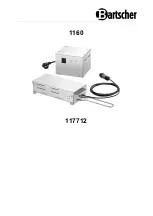
8
USING THE THERMOSTAT WITH SWITCH IN SERIES
(COOKERS WITH A SINGLE-CONTROL CONVENTIONAL ELECTRIC OVEN)
The electric oven is controlled by an electric thermostat combined with a switch used to turn on the elements (fig.25). The
electric oven can be combined with an electric grill (to use the grill see the specific pages). The oven is heated by 2 elements:
one on the top and one on the bottom. Turning the knob turns on the bottom element and the top external element while the
thermostat is used to set a temperature ranging from 50°C to 250°C. It can be adjusted using the scale indicated on the ring
around the knob. An orange light turns off indicating that the temperature setting has been reached. Therefore, it is normal for
this light to turn on and off while the oven is working. There are 3 fixed positions beyond the 250 °C setting:
- the symbol
indicates that only the bottom element (1800W ) has been turned on;
- the symbol
indicates that only the top external element (1200W ) has been turned on;
- the symbol
indicates that only the grill element (1800W ) has been turned on (see the specific paragraph).
In these positions the temperature is not controlled by the thermostat.
WARNING: When using the oven for the first time it should be operated for a maximum of 30 minutes at a temperature
of about 250° to eliminate any odours generated by the internal insulation.
During normal oven use, select the desired cooking temperature using the thermostat knob and wait until the orange light turns
off before putting in any food. The oven is equipped with 5 guides at different heights (fig.24) which can be used to insert
shelves or the tray. To keep the oven as clean as possible it is recommended to cook meat on the tray or on the shelf that has
been inserted inside the tray.
USING THE ELECTRIC THERMOSTAT (fig.26A-26B-26C)
( WITH A MULTIFUNCTION OVEN)
The thermostat supplied with the relative models maintains a constant temperature inside the oven at a specific temperature
setting ranging from 50°C to 250°C.
Turn the knob clockwise and align the selected temperature indicated on the ring with the index etched on the control panel.
Thermostat operation is indicated by an orange light which will turn off when the temperature inside the oven is 10°C greater
than the temperature setting, and will turn on when the oven is 10°C less than the temperature setting. The thermostat can
control the oven elements only if the relative switch is in one of the possible oven element operating modes: if the switch is in
position 0, the thermostat has not effect on the oven elements, which remain off.
USING THE 9 + 0 SWITCH (fig.27A-27B-27C)
The 9 + 0 switch installed in the multifunction oven models is used, along with the thermostat, to control the electric fan and the
oven elements since they can be turned on by turning the 9 + 0 switch knob and the thermostat knob. Turning just one of the
two knobs will not have any effect on the oven except to turn on the oven light or the electric fan when inserted. The electric
oven is heated by 4 elements: one on the bottom, two on the top or one circular; turning the switch knob turns on the element
relative to the symbol indicated on the ring but to be activated the thermostat knob must be turned until the orange light turns on
indicating that the element has been turned on. Placing the switch knob on any of the nine operating modes turns on the oven
light, together with the relative element. Once the temperature and the elements to be used have been set, the oven elements
are turned on and off by the thermostat; therefore, it is normal for the orange light to turn on and off while the oven is working.
To turn off the electric oven set the switch knob to position 0 to prevent the thermostat from controlling the elements. Setting the
thermostat knob to position 0 turns off the elements but it is still possible, using the switch, to turn on the electric fan and the
oven light.
The switch has 9 different fixed positions corresponding to 9 different types of oven operation:
- the symbol
or
indicates that only the oven light is turned on;
- the symbol
or
indicates that the bottom element (1300W)and the top external element (900W) have been turned on;
- the symbol
or
indicates that only the top external element (900W) has been turned on;
- the symbol
or
indicates the only the bottom element (1300W) has been turned on;
- the symbol
or
indicates that only the grill element (2000W) has been turned on;
- the symbol
or
indicates that the top external element (900W) and the grill element (2000W) have been turned on;
- the symbol
or
indicates that the top external element (900W), the grill element (2000W) and the electric fan have been
turned on;
- the symbol
or
indicates that the circular element (2400W) and the electric fan have been turned on;
- the symbol
or
indicates that only the electric fan has been turned on.
When the knob is set to one of these nine positions, the oven light is always on, thus indicating that the oven is being energised.
USING THE NATURAL CONVENTIONAL ELECTRIC OVEN
When using the oven for the first time it should be operated for a maximum of 30 minutes at a temperature of about 250° to
eliminate any odours generated by the internal insulation. During normal oven use, select the desired cooking temperature
using the thermostat knob and wait until the orange light turns off before putting in any food. The oven is equipped with 5 guides
at different heights (fig.24) which can be used to insert shelves or the tray. To keep the oven as clean as possible it is
recommended to cook meat on the tray or on the shelf that has been inserted inside the tray. Table No. 8 below lists the
cooking times and the position of the tray for different types of foods. Personal experience will help to determine any variations
in the values reported in the table. In any case, it is recommended to follow the instructions of the specific recipe being used.
Summary of Contents for AM64081DX/20
Page 11: ...11 Fig A Fig B Fig C Fig D Fig E Fig F...
Page 12: ...12 fig 1 fig 2 fig 3 fig 4 fig 5 fig 6 fig 7 fig 8 fig 9 fig 10 fig 11 fig 12...
Page 15: ...15 Fig 32C Fig 33 Fig 34 Fig 35...
Page 16: ......
Page 17: ......
Page 18: ......
Page 19: ......
Page 20: ......
Page 21: ......
Page 22: ......
Page 23: ......
Page 24: ......
Page 25: ......
Page 26: ......
Page 27: ...20 B 1 A 2 1 70 B 1 65 1 2 1 2 1 700 25 100 C D E F...
Page 28: ......









































